Subtraction Within 20
Definitions
Subtracting Numbers Within 10
Exercise
-
 \(-\)
\(-\)  \(=\)
\(=\) 
- \(9-1=8\)
Exercise
-
 \(-\)
\(-\)  \(=\)
\(=\) 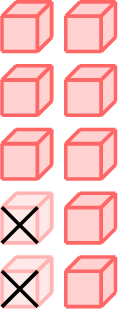
- \(10-2=8\)
Exercise
-
 \(-\)
\(-\)  \(=\)
\(=\) 
- \(7-3=4\)
Exercise
-
 \(-\)
\(-\)  \(=\)
\(=\) 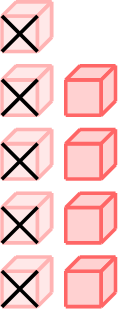
- \(9-5=4\)
Exercise
-
 \(-\)
\(-\)  \(=\)
\(=\) 
- \(6-2=4\)
Exercise
-
 \(-\)
\(-\)  \(=\)
\(=\) 
- \(8-3=5\)
Exercise
-
 \(-\)
\(-\)  \(=\)
\(=\) 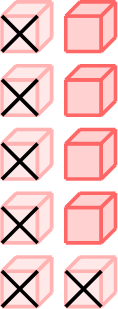
- \(10-6=4\)
Subtracting by Taking Away Units
Exercise
 \(-\)
\(-\) -
 \(-\)
\(-\)  \(=\)
\(=\) 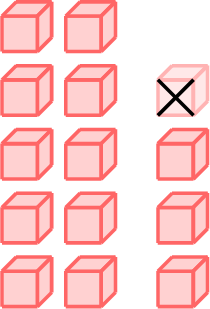
- \(14-1=13\)
Exercise
 \(-\)
\(-\) -
 \(-\)
\(-\)  \(=\)
\(=\) 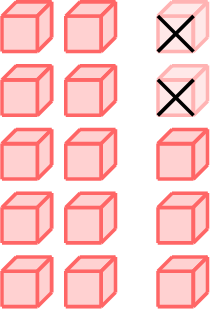
- \(15-2=13\)
Exercise
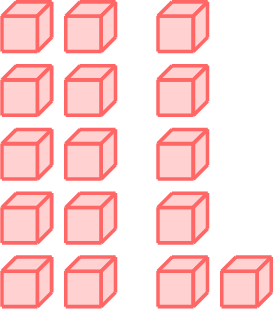 \(-\)
\(-\) -
 \(-\)
\(-\)  \(=\)
\(=\) 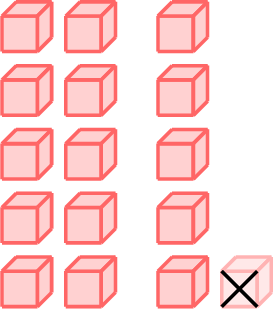
- \(16-1=15\)
Exercise
 \(-\)
\(-\) -
 \(-\)
\(-\)  \(=\)
\(=\) 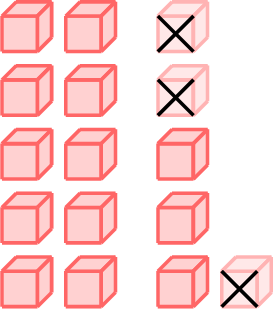
- \(16-3=13\)
Exercise
 \(-\)
\(-\) -
 \(-\)
\(-\)  \(=\)
\(=\) 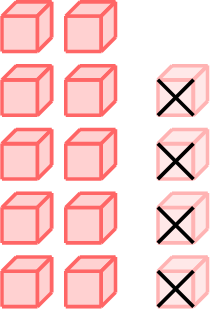
- \(14-4=10\)
Exercise
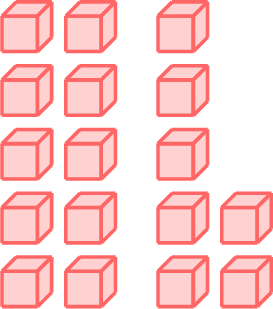 \(-\)
\(-\) -
 \(-\)
\(-\)  \(=\)
\(=\) 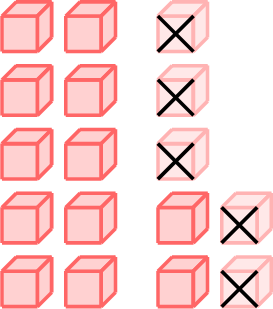
- \(17-5=12\)
Subtracting by Taking Away Units and One Ten
Exercise
 \(-\)
\(-\)  \(=\)
\(=\)-
 \(-\)
\(-\)  \(=\)
\(=\) 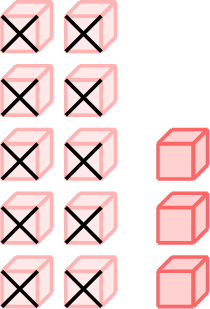
- \(13-10=3\)
Exercise
 \(-\)
\(-\)  \(=\)
\(=\)-
 \(-\)
\(-\)  \(=\)
\(=\) 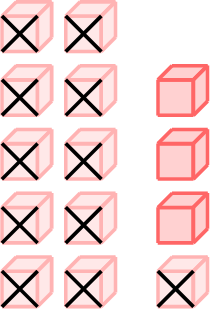
- \(14-11=3\)
Exercise
 \(-\)
\(-\) 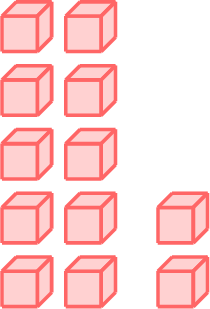 \(=\)
\(=\)-
 \(-\)
\(-\)  \(=\)
\(=\) 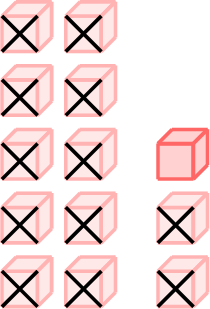
- \(13-12=1\)
Exercise
 \(-\)
\(-\)  \(=\)
\(=\)-
 \(-\)
\(-\)  \(=\)
\(=\) 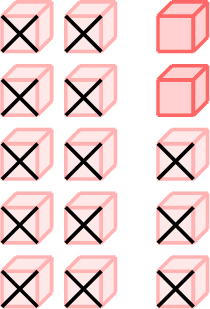
- \(15-13=2\)
Exercise
 \(-\)
\(-\)  \(=\)
\(=\)-
 \(-\)
\(-\)  \(=\)
\(=\) 
- \(13-10=3\)
Exercise
 \(-\)
\(-\)  \(=\)
\(=\)-
 \(-\)
\(-\)  \(=\)
\(=\) 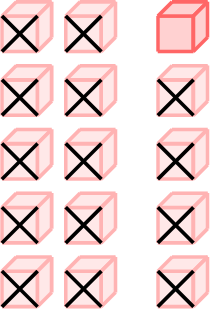
- \(15-14=1\)
Exercise
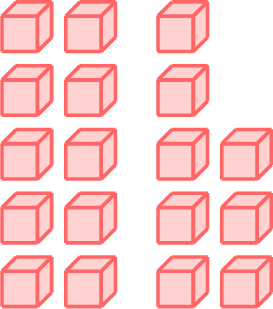 \(-\)
\(-\)  \(=\)
\(=\)-
 \(-\)
\(-\)  \(=\)
\(=\) 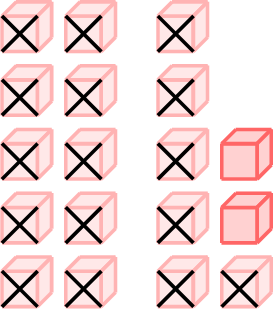
- \(18-16=2\)
Subtracting Multiple Numbers
Exercise
-
 \(-\)
\(-\)  \(-\)
\(-\)  \(=\)
\(=\)  \(-\)
\(-\) 
 \(\textcolor{white}{-}\)
\(\textcolor{white}{-}\)  \(\textcolor{white}{-}\)
\(\textcolor{white}{-}\)  \(=\)
\(=\) 
- \(\begin{aligned}[t]5 - 1 - 1 &= 4 - 1\\&= 3\\\end{aligned}\)
Exercise
-
 \(-\)
\(-\)  \(-\)
\(-\)  \(=\)
\(=\)  \(-\)
\(-\) 
 \(\textcolor{white}{-}\)
\(\textcolor{white}{-}\)  \(\textcolor{white}{-}\)
\(\textcolor{white}{-}\)  \(=\)
\(=\) 
- \(\begin{aligned}[t]5-2-1&=3-1\\&=2\\\end{aligned}\)
Exercise
 \(-\)
\(-\) -
 \(-\)
\(-\)  \(-\)
\(-\)  \(=\)
\(=\)  \(-\)
\(-\) 
 \(\textcolor{white}{-}\)
\(\textcolor{white}{-}\)  \(\textcolor{white}{-}\)
\(\textcolor{white}{-}\)  \(=\)
\(=\) 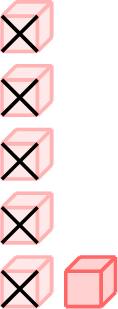
- \(\begin{aligned}[t]6 - 3 - 2 &= 3 - 2\\&= 1\\\end{aligned}\)
Exercise
 \(-\)
\(-\) -
 \(-\)
\(-\)  \(-\)
\(-\)  \(=\)
\(=\)  \(-\)
\(-\) 
 \(\textcolor{white}{-}\)
\(\textcolor{white}{-}\)  \(\textcolor{white}{-}\)
\(\textcolor{white}{-}\)  \(=\)
\(=\) 
- \(\begin{aligned}[t]7 - 1 - 3 &= 6 - 3\\&= 3\\\end{aligned}\)
Exercise
 \(-\)
\(-\) -
 \(-\)
\(-\)  \(-\)
\(-\)  \(=\)
\(=\)  \(-\)
\(-\) 
 \(\textcolor{white}{-}\)
\(\textcolor{white}{-}\)  \(\textcolor{white}{-}\)
\(\textcolor{white}{-}\)  \(=\)
\(=\) 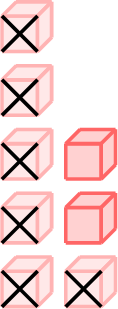
- \(\begin{aligned}[t]8 - 2 - 4 &= 6 - 4\\&= 2\\\end{aligned}\)
Exercise
 \(-\)
\(-\) -
 \(-\)
\(-\)  \(-\)
\(-\)  \(=\)
\(=\)  \(-\)
\(-\) 
7 \(\textcolor{white}{-}\)
\(\textcolor{white}{-}\)  \(\textcolor{white}{-}\)
\(\textcolor{white}{-}\)  \(=\)
\(=\) 
- \(\begin{aligned}[t]6 - 4 - 1 &= 2 - 1\\&= 1\\\end{aligned}\)
Exercise
 \(-\)
\(-\) -
 \(-\)
\(-\)  \(-\)
\(-\)  \(=\)
\(=\) 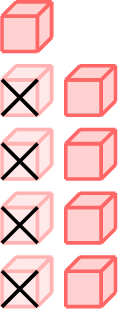 \(-\)
\(-\) 
 \(\textcolor{white}{-}\)
\(\textcolor{white}{-}\)  \(\textcolor{white}{-}\)
\(\textcolor{white}{-}\)  \(=\)
\(=\) 
- \(\begin{aligned}[t]9 - 4 - 3 &= 5 - 3\\&= 2\\\end{aligned}\)
Breaking Down Numbers
Exercise
-
 \(=\)
\(=\)  \(+\)
\(+\) 
- \(3=\textcolor{colordef}{2}+\textcolor{colorprop}{1}\)
Exercise
-
 \(=\)
\(=\)  \(+\)
\(+\) 
- \(5 = \textcolor{colordef}{3} + \textcolor{colorprop}{2}\)
Exercise
-
 \(=\)
\(=\)  \(+\)
\(+\) 
- \(4 = \textcolor{colordef}{1} + \textcolor{colorprop}{3}\)
Exercise
-
 \(=\)
\(=\)  \(+\)
\(+\) 
- \(7 = \textcolor{colordef}{4} + \textcolor{colorprop}{3}\)
Exercise
-
 \(=\)
\(=\)  \(+\)
\(+\) 
- \(8 = \textcolor{colordef}{3} + \textcolor{colorprop}{5}\)
Exercise
-
 \(=\)
\(=\)  \(+\)
\(+\) 
- \(9 = \textcolor{colordef}{7} + \textcolor{colorprop}{2}\)
Exercise
-
 \(=\)
\(=\)  \(+\)
\(+\) 
- \(10 = \textcolor{colordef}{6} + \textcolor{colorprop}{4}\)
Number Line Method
Subtracting Using the Number Line
Exercise
-

- \(13-4=9\)
Exercise
-

- \(12-6=6\)
Exercise
-

- \(14-5=9\)
Exercise
-

- \(15-6=9\)
Exercise
-

- \(11-6=5\)
Exercise
-

- \(11-6=5\)
Making 10 Method
Breaking Down Numbers to Make Ten
Exercise
-
 \(-\)
\(-\)  \(=\)
\(=\)  \(-\)
\(-\)  \(-\)
\(-\) 
- \(11-3=11-1-2\)
Exercise
-
 \(-\)
\(-\)  \(=\)
\(=\)  \(-\)
\(-\)  \(-\)
\(-\) 
- \(12 - 3 = 12 - 2 - 1\)
Exercise
-
 \(-\)
\(-\)  \(=\)
\(=\)  \(-\)
\(-\)  \(-\)
\(-\) 
- \(14 - 6 = 14 - 4 - 2\)
Exercise
-
 \(-\)
\(-\)  \(=\)
\(=\)  \(-\)
\(-\)  \(-\)
\(-\) 
- \(11 - 9 = 11 - 1 - 8\)
Exercise
-
 \(-\)
\(-\)  \(=\)
\(=\)  \(-\)
\(-\)  \(-\)
\(-\) 
- \(11 - 9 = 11 - 1 - 8\)
Exercise
-
 \(-\)
\(-\)  \(=\)
\(=\)  \(-\)
\(-\)  \(-\)
\(-\) 
- \(13 - 7 = 13 - 3 - 4\)
Exercise
-
 \(-\)
\(-\)  \(=\)
\(=\)  \(-\)
\(-\)  \(-\)
\(-\) 
- \(15 - 9 = 15 - 5 - 4\)
Subtracting from Ten
Exercise
-
 \(-\)
\(-\)  \(=\)
\(=\) 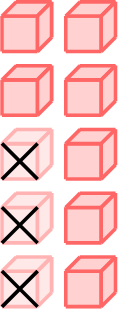
- \(10 - 3=7\)
Exercise
-
 \(-\)
\(-\)  \(=\)
\(=\) 
- \(10 - 2=8\)
Exercise
-
 \(-\)
\(-\)  \(=\)
\(=\) 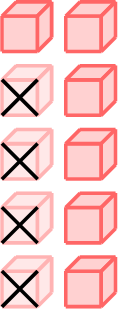
- \(10 - 4=6\)
Exercise
-
 \(-\)
\(-\)  \(=\)
\(=\) 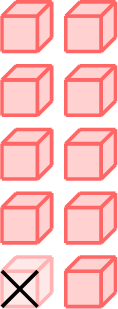
- \(10 - 1=9\)
Exercise
-
 \(-\)
\(-\)  \(=\)
\(=\) 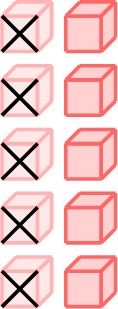
- \(10 - 5=5\)
Exercise
-
 \(-\)
\(-\)  \(=\)
\(=\) 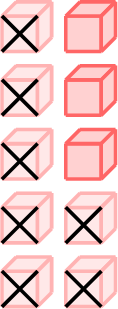
- \(10 - 7=3\)
Exercise
-
 \(-\)
\(-\)  \(=\)
\(=\) 
- \(10 - 6=4\)
Making 10 after Breaking Down Numbers
Exercise
| \(13-5\) | \(=\) | \(13-3-2\) |
| \(=\) |
-
 \(-\)
\(-\)  \(=\)
\(=\)  \(-\)
\(-\)  \(-\)
\(-\) 
 \(\textcolor{white}{-}\)
\(\textcolor{white}{-}\)  \(=\)
\(=\) 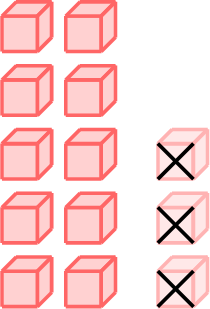 \(-\)
\(-\) 
 \(\textcolor{white}{-}\)
\(\textcolor{white}{-}\)  \(=\)
\(=\) 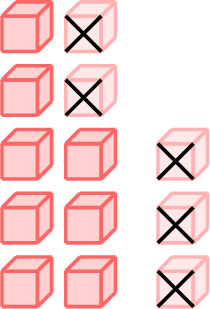
- \(\begin{aligned}[t]13 - 5&=13 - 3 - 2\\&=10 - 2\\&=8\\\end{aligned}\)
Exercise
| \(17-8\) | \(=\) | \(17-7-1\) |
| \(=\) |
-
 \(-\)
\(-\)  \(=\)
\(=\)  \(-\)
\(-\)  \(-\)
\(-\) 
 \(\textcolor{white}{-}\)
\(\textcolor{white}{-}\)  \(=\)
\(=\) 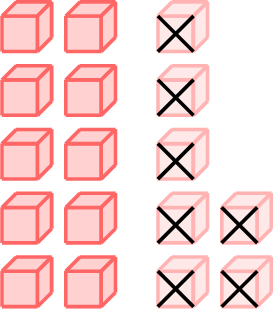 \(-\)
\(-\) 
 \(\textcolor{white}{-}\)
\(\textcolor{white}{-}\)  \(=\)
\(=\) 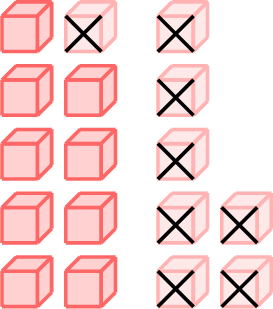
- \(\begin{aligned}[t]17 - 8 &= 17 - 7 - 1\\&=10 - 1\\&=9\\\end{aligned}\)
Exercise
| \(16-8\) | \(=\) | \(16-6-2\) |
| \(=\) |
-
 \(-\)
\(-\)  \(=\)
\(=\)  \(-\)
\(-\)  \(-\)
\(-\) 
 \(\textcolor{white}{-}\)
\(\textcolor{white}{-}\)  \(=\)
\(=\) 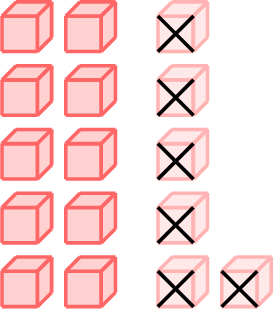 \(-\)
\(-\) 
 \(\textcolor{white}{-}\)
\(\textcolor{white}{-}\)  \(=\)
\(=\) 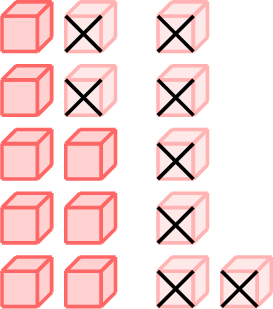
- \(\begin{aligned}[t]16 - 8 &= 16 - 6 - 2\\&=10 - 2\\&=8\\\end{aligned}\)
Exercise
| \(15-8\) | \(=\) | \(15-5-3\) |
| \(=\) |
-
 \(-\)
\(-\)  \(=\)
\(=\)  \(-\)
\(-\)  \(-\)
\(-\) 
 \(\textcolor{white}{-}\)
\(\textcolor{white}{-}\)  \(=\)
\(=\) 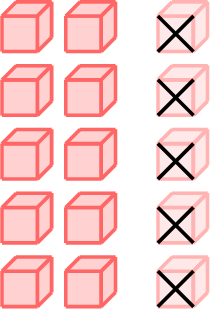 \(-\)
\(-\) 
 \(\textcolor{white}{-}\)
\(\textcolor{white}{-}\)  \(=\)
\(=\) 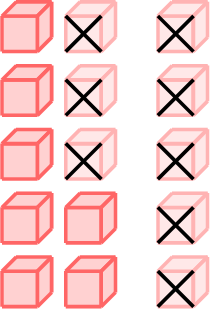
- \(\begin{aligned}[t]15 - 8 &= 15 - 5 - 3\\&=10 - 3\\&=7\\\end{aligned}\)
Exercise
| \(14-7\) | \(=\) | \(14-4-3\) |
| \(=\) |
-
 \(-\)
\(-\)  \(=\)
\(=\)  \(-\)
\(-\)  \(-\)
\(-\) 
 \(\textcolor{white}{-}\)
\(\textcolor{white}{-}\)  \(=\)
\(=\)  \(-\)
\(-\) 
 \(\textcolor{white}{-}\)
\(\textcolor{white}{-}\)  \(=\)
\(=\) 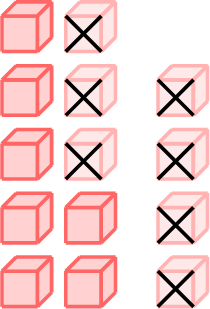
- \(\begin{aligned}[t]14 - 7 &= 14 - 4 - 3\\&=10 - 3\\&=7\\\end{aligned}\)
Exercise
| \(18-9\) | \(=\) | \(18-8-1\) |
| \(=\) |
-
 \(-\)
\(-\)  \(=\)
\(=\)  \(-\)
\(-\)  \(-\)
\(-\) 
 \(\textcolor{white}{-}\)
\(\textcolor{white}{-}\)  \(=\)
\(=\) 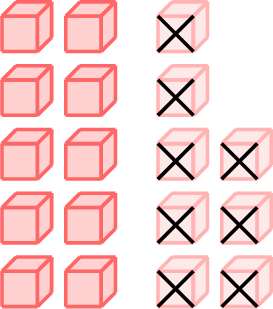 \(-\)
\(-\) 
 \(\textcolor{white}{-}\)
\(\textcolor{white}{-}\)  \(=\)
\(=\) 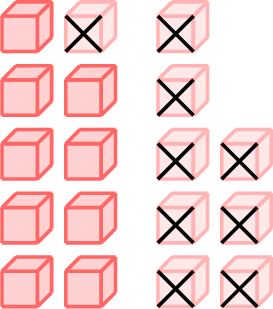
- \(\begin{aligned}[t]18 - 9 &= 18 - 8 - 1\\&=10 - 1\\&=9\\\end{aligned}\)
Exercise
| \(13-7\) | \(=\) | \(13-3-4\) |
| \(=\) |
-
 \(-\)
\(-\)  \(=\)
\(=\)  \(-\)
\(-\)  \(-\)
\(-\) 
 \(\textcolor{white}{-}\)
\(\textcolor{white}{-}\)  \(=\)
\(=\)  \(-\)
\(-\) 
 \(\textcolor{white}{-}\)
\(\textcolor{white}{-}\)  \(=\)
\(=\) 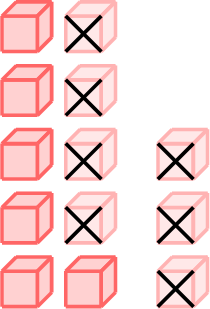
- \(\begin{aligned}[t]13 - 7 &= 13 - 3 - 4\\&=10 - 4\\&=6\\\end{aligned}\)
Exercise
| \(13-9\) | \(=\) | \(13-3-6\) |
| \(=\) |
-
 \(-\)
\(-\)  \(=\)
\(=\)  \(-\)
\(-\)  \(-\)
\(-\) 
 \(\textcolor{white}{-}\)
\(\textcolor{white}{-}\)  \(=\)
\(=\)  \(-\)
\(-\) 
 \(\textcolor{white}{-}\)
\(\textcolor{white}{-}\)  \(=\)
\(=\) 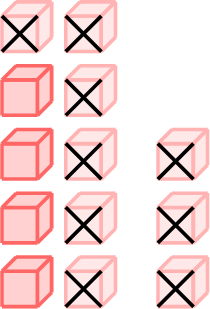
- \(\begin{aligned}[t]13 - 9 &= 13 - 3 - 6\\&=10 - 6\\&=4\\\end{aligned}\)
Subtracting Number Within 20
Exercise
-
 \(-\)
\(-\)  \(=\)
\(=\)  \(-\)
\(-\)  \(-\)
\(-\) 
 \(\textcolor{white}{-}\)
\(\textcolor{white}{-}\)  \(=\)
\(=\)  \(-\)
\(-\) 
 \(\textcolor{white}{-}\)
\(\textcolor{white}{-}\)  \(=\)
\(=\) 
- \(\begin{aligned}[t]13 - 5&=13 - 3 - 2\\&=10 - 2\\&=8\\\end{aligned}\)
Exercise
-
 \(-\)
\(-\)  \(=\)
\(=\)  \(-\)
\(-\)  \(-\)
\(-\) 
 \(\textcolor{white}{-}\)
\(\textcolor{white}{-}\)  \(=\)
\(=\)  \(-\)
\(-\) 
 \(\textcolor{white}{-}\)
\(\textcolor{white}{-}\)  \(=\)
\(=\) 
- \(\begin{aligned}[t]17 - 8 &= 17 - 7 - 1\\&=10 - 1\\&=9\\\end{aligned}\)
Exercise
-
 \(-\)
\(-\)  \(=\)
\(=\)  \(-\)
\(-\)  \(-\)
\(-\) 
 \(\textcolor{white}{-}\)
\(\textcolor{white}{-}\)  \(=\)
\(=\)  \(-\)
\(-\) 
 \(\textcolor{white}{-}\)
\(\textcolor{white}{-}\)  \(=\)
\(=\) 
- \(\begin{aligned}[t]16 - 8 &= 16 - 6 - 2\\&=10 - 2\\&=8\\\end{aligned}\)
Exercise
-
 \(-\)
\(-\)  \(=\)
\(=\)  \(-\)
\(-\)  \(-\)
\(-\) 
 \(\textcolor{white}{-}\)
\(\textcolor{white}{-}\)  \(=\)
\(=\)  \(-\)
\(-\) 
 \(\textcolor{white}{-}\)
\(\textcolor{white}{-}\)  \(=\)
\(=\) 
- \(\begin{aligned}[t]15 - 8 &= 15 - 5 - 3\\&=10 - 3\\&=7\\\end{aligned}\)
Exercise
-
 \(-\)
\(-\)  \(=\)
\(=\)  \(-\)
\(-\)  \(-\)
\(-\) 
 \(\textcolor{white}{-}\)
\(\textcolor{white}{-}\)  \(=\)
\(=\)  \(-\)
\(-\) 
 \(\textcolor{white}{-}\)
\(\textcolor{white}{-}\)  \(=\)
\(=\) 
- \(\begin{aligned}[t]14 - 7 &= 14 - 4 - 3\\&=10 - 3\\&=7\\\end{aligned}\)
Exercise
-
 \(-\)
\(-\)  \(=\)
\(=\)  \(-\)
\(-\)  \(-\)
\(-\) 
 \(\textcolor{white}{-}\)
\(\textcolor{white}{-}\)  \(=\)
\(=\)  \(-\)
\(-\) 
 \(\textcolor{white}{-}\)
\(\textcolor{white}{-}\)  \(=\)
\(=\) 
- \(\begin{aligned}[t]18 - 9 &= 18 - 8 - 1\\&=10 - 1\\&=9\\\end{aligned}\)
Exercise
-
 \(-\)
\(-\)  \(=\)
\(=\)  \(-\)
\(-\)  \(-\)
\(-\) 
 \(\textcolor{white}{-}\)
\(\textcolor{white}{-}\)  \(=\)
\(=\)  \(-\)
\(-\) 
 \(\textcolor{white}{-}\)
\(\textcolor{white}{-}\)  \(=\)
\(=\) 
- \(\begin{aligned}[t]13 - 7 &= 13 - 3 - 4\\&=10 - 4\\&=6\\\end{aligned}\)
Exercise
-
 \(-\)
\(-\)  \(=\)
\(=\)  \(-\)
\(-\)  \(-\)
\(-\) 
 \(\textcolor{white}{-}\)
\(\textcolor{white}{-}\)  \(=\)
\(=\)  \(-\)
\(-\) 
 \(\textcolor{white}{-}\)
\(\textcolor{white}{-}\)  \(=\)
\(=\) 
- \(\begin{aligned}[t]13 - 9 &= 13 - 3 - 6\\&=10 - 6\\&=4\\\end{aligned}\)
Addition and Subtraction Link
Finding Subtraction Using Addition
Exercise
If we know that \(\textcolor{colordef}{17}+\textcolor{colorprop}{14}=\textcolor{olive}{31}\), then \(\textcolor{olive}{31}-\textcolor{colordef}{17}=\) .

- We add to find the total:$$\begin{aligned}\textcolor{colordef}{\text{part 1}} + \textcolor{colorprop}{\text{part 2}}&=\textcolor{olive}{\text{total}}\\ \textcolor{colordef}{17}+\textcolor{colorprop}{14} &= \textcolor{olive}{31}\end{aligned}$$
- We subtract to find a part:$$\begin{aligned} \textcolor{olive}{\text{total}}- \textcolor{colordef}{\text{part 1}}&=\textcolor{colorprop}{\text{part 2}}\\ \textcolor{olive}{31} - \textcolor{colordef}{17} &= \textcolor{colorprop}{14}\end{aligned}$$
Exercise
If we know that \(\textcolor{colordef}{50}+\textcolor{colorprop}{45}=\textcolor{olive}{95}\), then \(\textcolor{olive}{95}-\textcolor{colordef}{50}=\) .

- We add to find the total:$$\begin{aligned}\textcolor{colordef}{\text{part 1}} + \textcolor{colorprop}{\text{part 2}}&=\textcolor{olive}{\text{total}}\\ \textcolor{colordef}{50}+\textcolor{colorprop}{45} &= \textcolor{olive}{95}\end{aligned}$$
- We subtract to find a part:$$\begin{aligned} \textcolor{olive}{\text{total}}- \textcolor{colordef}{\text{part 1}}&=\textcolor{colorprop}{\text{part 2}}\\ \textcolor{olive}{95} - \textcolor{colordef}{50} &= \textcolor{colorprop}{45}\end{aligned}$$
Exercise
If we know that \(\textcolor{colordef}{18}+\textcolor{colorprop}{82}=\textcolor{olive}{100}\), then \(\textcolor{olive}{100}-\textcolor{colordef}{18}=\) .

- We add to find the total:$$\begin{aligned}\textcolor{colordef}{\text{part 1}} + \textcolor{colorprop}{\text{part 2}}&=\textcolor{olive}{\text{total}}\\ \textcolor{colordef}{18}+\textcolor{colorprop}{82} &= \textcolor{olive}{100}\end{aligned}$$
- We subtract to find a part:$$\begin{aligned} \textcolor{olive}{\text{total}}- \textcolor{colordef}{\text{part 1}}&=\textcolor{colorprop}{\text{part 2}}\\ \textcolor{olive}{100} - \textcolor{colordef}{18} &= \textcolor{colorprop}{82}\end{aligned}$$
Exercise
If we know that \(\textcolor{colordef}{78}+\textcolor{colorprop}{2}=\textcolor{olive}{80}\), then \(\textcolor{olive}{80}-\textcolor{colordef}{78}=\) .

- We add to find the total:$$\begin{aligned}\textcolor{colordef}{\text{part 1}} + \textcolor{colorprop}{\text{part 2}}&=\textcolor{olive}{\text{total}}\\ \textcolor{colordef}{78}+\textcolor{colorprop}{2} &= \textcolor{olive}{80}\end{aligned}$$
- We subtract to find a part:$$\begin{aligned} \textcolor{olive}{\text{total}}- \textcolor{colordef}{\text{part 1}}&=\textcolor{colorprop}{\text{part 2}}\\ \textcolor{olive}{80} - \textcolor{colordef}{78} &= \textcolor{colorprop}{2}\end{aligned}$$
Finding the Missing Subtrahend
Exercise
-

- \(\begin{aligned}[t] \textcolor{olive}{\text{total}}- \textcolor{colordef}{\text{part}}&=\textcolor{colorprop}{\text{part}}\\\textcolor{olive}{\text{total}}- \textcolor{colorprop}{\text{part}}&=\textcolor{colordef}{\text{part}}\end{aligned}\)
- \(\begin{aligned}[t]\textcolor{olive}{4}- \textcolor{colordef}{1}&=\textcolor{colorprop}{3}\\\textcolor{olive}{4}- \textcolor{colorprop}{3}&=\textcolor{colordef}{1}\end{aligned}\)
Exercise
-

- \(\begin{aligned}[t] \textcolor{olive}{\text{total}}- \textcolor{colordef}{\text{part}}&=\textcolor{colorprop}{\text{part}}\\\textcolor{olive}{\text{total}}- \textcolor{colorprop}{\text{part}}&=\textcolor{colordef}{\text{part}}\end{aligned}\)
- \(\begin{aligned}[t]\textcolor{olive}{5}- \textcolor{colordef}{2}&=\textcolor{colorprop}{3}\\\textcolor{olive}{5}- \textcolor{colorprop}{3}&=\textcolor{colordef}{2}\end{aligned}\)
Exercise
-

- \(\begin{aligned}[t] \textcolor{olive}{\text{total}}- \textcolor{colordef}{\text{part}}&=\textcolor{colorprop}{\text{part}}\\\textcolor{olive}{\text{total}}- \textcolor{colorprop}{\text{part}}&=\textcolor{colordef}{\text{part}}\end{aligned}\)
- \(\begin{aligned}[t]\textcolor{olive}{7}- \textcolor{colordef}{5}&=\textcolor{colorprop}{2}\\\textcolor{olive}{7}- \textcolor{colorprop}{2}&=\textcolor{colordef}{5}\end{aligned}\)
Exercise
-

- \(\begin{aligned}[t] \textcolor{olive}{\text{total}}- \textcolor{colordef}{\text{part}}&=\textcolor{colorprop}{\text{part}}\\\textcolor{olive}{\text{total}}- \textcolor{colorprop}{\text{part}}&=\textcolor{colordef}{\text{part}}\end{aligned}\)
- \(\begin{aligned}[t]\textcolor{olive}{6}- \textcolor{colordef}{2}&=\textcolor{colorprop}{4}\\\textcolor{olive}{6}- \textcolor{colorprop}{4}&=\textcolor{colordef}{2}\end{aligned}\)
Exercise
-

- \(\begin{aligned}[t] \textcolor{olive}{\text{total}}- \textcolor{colordef}{\text{part}}&=\textcolor{colorprop}{\text{part}}\\\textcolor{olive}{\text{total}}- \textcolor{colorprop}{\text{part}}&=\textcolor{colordef}{\text{part}}\end{aligned}\)
- \(\begin{aligned}[t]\textcolor{olive}{8}- \textcolor{colordef}{3}&=\textcolor{colorprop}{5}\\\textcolor{olive}{8}- \textcolor{colorprop}{5}&=\textcolor{colordef}{3}\end{aligned}\)
Finding the Total in Subtraction Problems
Exercise
-

- \(\begin{aligned}[t] \textcolor{olive}{\text{total}}- \textcolor{colordef}{\text{part}}&=\textcolor{colorprop}{\text{part}}\\\textcolor{olive}{\text{total}}&=\textcolor{colordef}{\text{part}}+\textcolor{colorprop}{\text{part}}\end{aligned}\)
- \(\begin{aligned}[t]\textcolor{olive}{5}&= \textcolor{colordef}{2}+\textcolor{colorprop}{3}\\\textcolor{olive}{5}- \textcolor{colordef}{2}&=\textcolor{colorprop}{3}\end{aligned}\)
Exercise
-

- \(\begin{aligned}[t] \textcolor{olive}{\text{total}}- \textcolor{colordef}{\text{part}}&=\textcolor{colorprop}{\text{part}}\\\textcolor{olive}{\text{total}}&=\textcolor{colordef}{\text{part}}+\textcolor{colorprop}{\text{part}}\end{aligned}\)
- \(\begin{aligned}[t]\textcolor{olive}{6}&= \textcolor{colordef}{4}+\textcolor{colorprop}{2}\\\textcolor{olive}{6}- \textcolor{colordef}{4}&=\textcolor{colorprop}{2}\end{aligned}\)
Exercise
-

- \(\begin{aligned}[t] \textcolor{olive}{\text{total}}- \textcolor{colordef}{\text{part}}&=\textcolor{colorprop}{\text{part}}\\\textcolor{olive}{\text{total}}&=\textcolor{colordef}{\text{part}}+\textcolor{colorprop}{\text{part}}\end{aligned}\)
- \(\begin{aligned}[t]\textcolor{olive}{7}&= \textcolor{colordef}{3}+\textcolor{colorprop}{4}\\\textcolor{olive}{7}- \textcolor{colordef}{3}&=\textcolor{colorprop}{4}\end{aligned}\)
Exercise
-

- \(\begin{aligned}[t] \textcolor{olive}{\text{total}}- \textcolor{colordef}{\text{part}}&=\textcolor{colorprop}{\text{part}}\\\textcolor{olive}{\text{total}}&=\textcolor{colordef}{\text{part}}+\textcolor{colorprop}{\text{part}}\end{aligned}\)
- \(\begin{aligned}[t]\textcolor{olive}{8}&= \textcolor{colordef}{5}+\textcolor{colorprop}{3}\\\textcolor{olive}{8}- \textcolor{colordef}{5}&=\textcolor{colorprop}{3}\end{aligned}\)
Exercise
-

- \(\begin{aligned}[t] \textcolor{olive}{\text{total}}- \textcolor{colordef}{\text{part}}&=\textcolor{colorprop}{\text{part}}\\\textcolor{olive}{\text{total}}&=\textcolor{colordef}{\text{part}}+\textcolor{colorprop}{\text{part}}\end{aligned}\)
- \(\begin{aligned}[t]\textcolor{olive}{9}&= \textcolor{colordef}{6}+\textcolor{colorprop}{3}\\\textcolor{olive}{9}- \textcolor{colordef}{6}&=\textcolor{colorprop}{3}\end{aligned}\)
Finding the Missing Addend
Exercise
-
 \(+\)
\(+\) \(=\)
\(=\)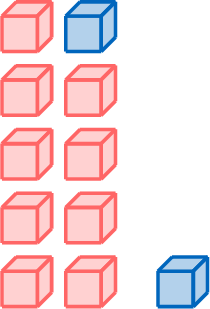
- \(\textcolor{colordef}{9}+\textcolor{colorprop}{2}=\textcolor{olive}{11}\)
-

Exercise
-
 \(+\)
\(+\) \(=\)
\(=\)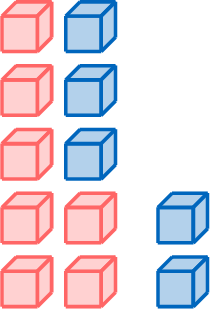
- \(\textcolor{colordef}{7}+\textcolor{colorprop}{5}=\textcolor{olive}{12}\)
-

Exercise
-
 \(+\)
\(+\) \(=\)
\(=\)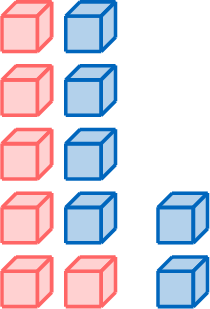
- \(\textcolor{colordef}{6}+\textcolor{colorprop}{6}=\textcolor{olive}{12}\)
-

Exercise
-
 \(+\)
\(+\) \(=\)
\(=\)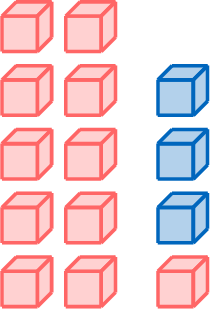
- \(\textcolor{colordef}{11}+\textcolor{colorprop}{3}=\textcolor{olive}{14}\)
-

Exercise
-
 \(+\)
\(+\) \(=\)
\(=\)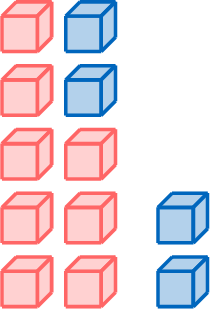
- \(\textcolor{colordef}{8}+\textcolor{colorprop}{4}=\textcolor{olive}{12}\)
-

Exercise
-
 \(+\)
\(+\) \(=\)
\(=\)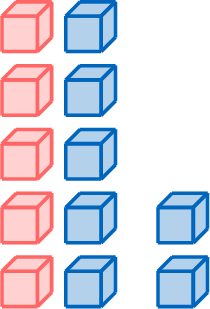
- \(\textcolor{colordef}{5}+\textcolor{colorprop}{7}=\textcolor{olive}{12}\)
-

Exercise
-
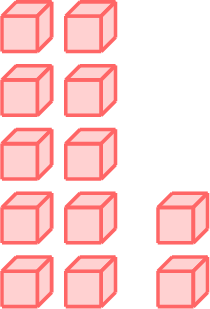 \(+\)
\(+\) \(=\)
\(=\)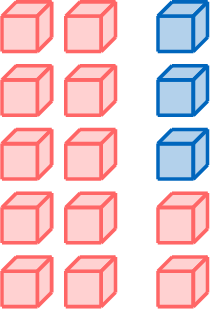
- \(\textcolor{colordef}{12}+\textcolor{colorprop}{3}=\textcolor{olive}{15}\)
-

Subtracting by Thinking Addition
Exercise

- \(\textcolor{colordef}{15}+\textcolor{colorprop}{2}=\textcolor{olive}{17}\)
- \(\textcolor{olive}{17}-\textcolor{colordef}{15}=\textcolor{colorprop}{2}\)
-

Exercise

- \(\textcolor{colordef}{9}+\textcolor{colorprop}{2}=\textcolor{olive}{11}\)
- \(\textcolor{olive}{11}-\textcolor{colordef}{9}=\textcolor{colorprop}{2}\)
-

Exercise

- \(\textcolor{colordef}{15}+\textcolor{colorprop}{4}=\textcolor{olive}{19}\)
- \(\textcolor{olive}{19}-\textcolor{colordef}{15}=\textcolor{colorprop}{4}\)
-

Exercise

- \(\textcolor{colordef}{8}+\textcolor{colorprop}{4}=\textcolor{olive}{12}\)
- \(\textcolor{olive}{12}-\textcolor{colordef}{8}=\textcolor{colorprop}{4}\)
-

Exercise

- \(\textcolor{colordef}{11}+\textcolor{colorprop}{2}=\textcolor{olive}{13}\)
- \(\textcolor{olive}{13}-\textcolor{colordef}{11}=\textcolor{colorprop}{2}\)
-

Exercise

- \(\textcolor{colordef}{9}+\textcolor{colorprop}{5}=\textcolor{olive}{14}\)
- \(\textcolor{olive}{14}-\textcolor{colordef}{9}=\textcolor{colorprop}{5}\)
-

Exercise

- \(\textcolor{colordef}{11}+\textcolor{colorprop}{5}=\textcolor{olive}{16}\)
- \(\textcolor{olive}{16}-\textcolor{colordef}{11}=\textcolor{colorprop}{5}\)
-

Problem-Solving Methods
Solving Real-World Problems
Exercise
Hugo and Louis are looking for shells. Hugo found 6 shells, and Louis found 9 shells.
How many shells do they have together in total? shells
How many shells do they have together in total?
- To find the total number of shells, start with the number of shells Hugo found, then add the number of shells Louis found.
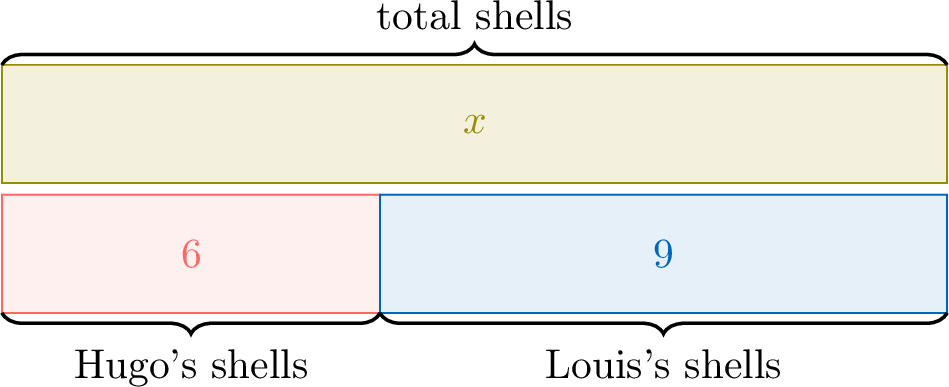
- So, the total number of shells is \(\textcolor{colordef}{6} + \textcolor{colorprop}{9}=\textcolor{olive}{15}\).
 \(+\)
\(+\) \(=\)
\(=\)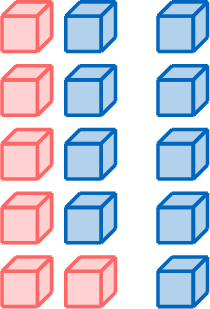
Exercise
Last month, Louis weighed 14 kilos. This month, he gained 5 kilos. How much does Louis weigh now? kilos
- To find Louis's current weight, start with last month's weight, and then add the weight gained this month.
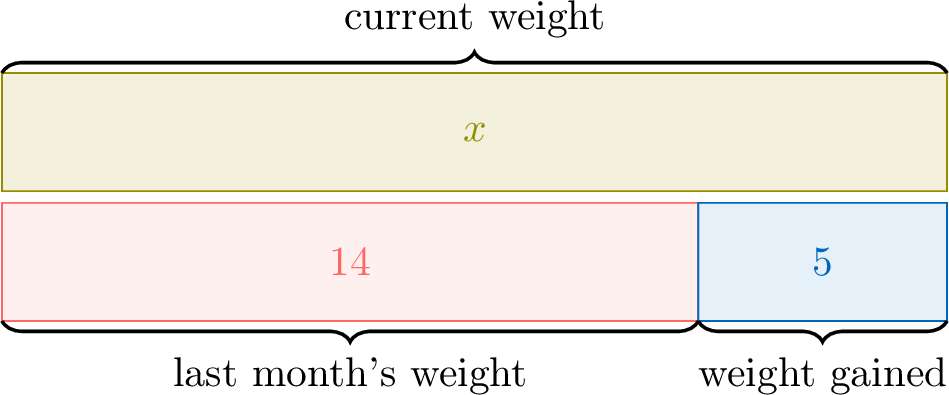
- So, Louis’s weight is now \(\textcolor{colordef}{14} + \textcolor{colorprop}{5}=\textcolor{olive}{19}\) kilos.
 \(+\)
\(+\) \(=\)
\(=\)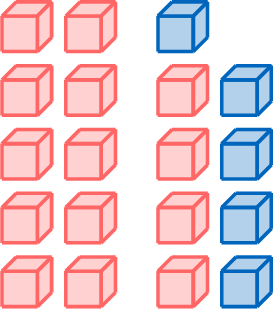
Exercise
A bookshelf has 11 books. You take 3 books to read.
How many books are left on the bookshelf? books
How many books are left on the bookshelf?
- Start with the total of 11 books and subtract the 3 books that you took.
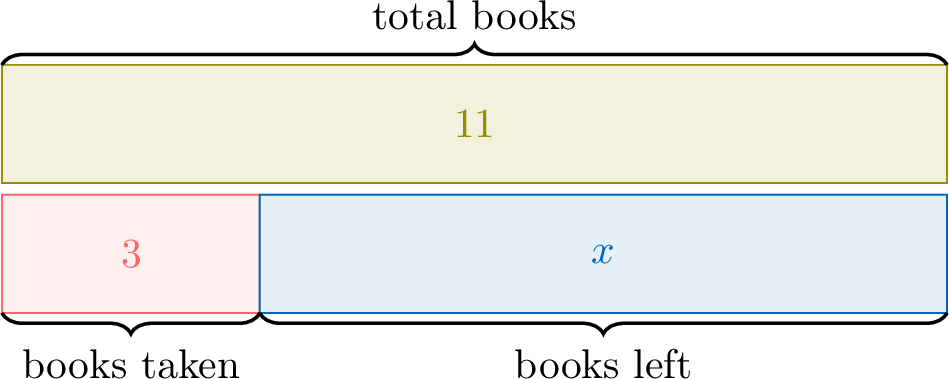
- The books left are \(\textcolor{olive}{11} - \textcolor{colordef}{3}=\textcolor{colorprop}{8}\)
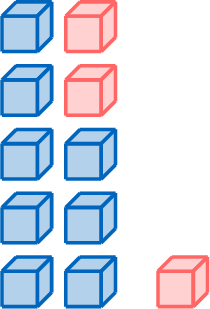 \(-\)
\(-\) \(=\)
\(=\)
Exercise
Su has saved 12 dollars from her allowance. Li has saved 5 dollars more than Su.
How much money has Li saved? dollars
How much money has Li saved?
- To find the amount Li has saved, start with the amount Su saved, and add the extra amount Li saved.
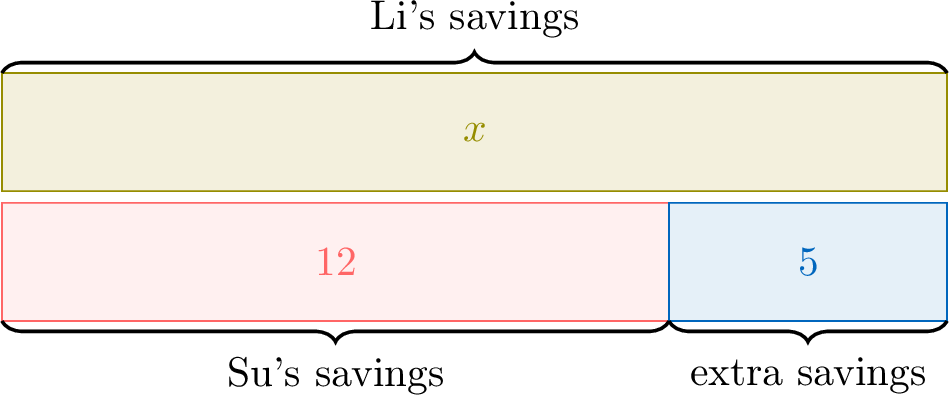
- So, the total savings for Li is \(\textcolor{colordef}{12} + \textcolor{colorprop}{5}=\textcolor{olive}{17}\) dollars.
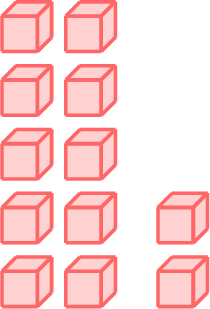 \(+\)
\(+\) \(=\)
\(=\)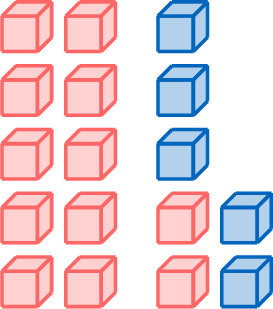
Exercise
You have 17 marbles. You give 4 marbles to a friend.
How many marbles do you have left? marbles
How many marbles do you have left?
- Start with the total of 17 marbles and subtract the 4 marbles that you gave away.
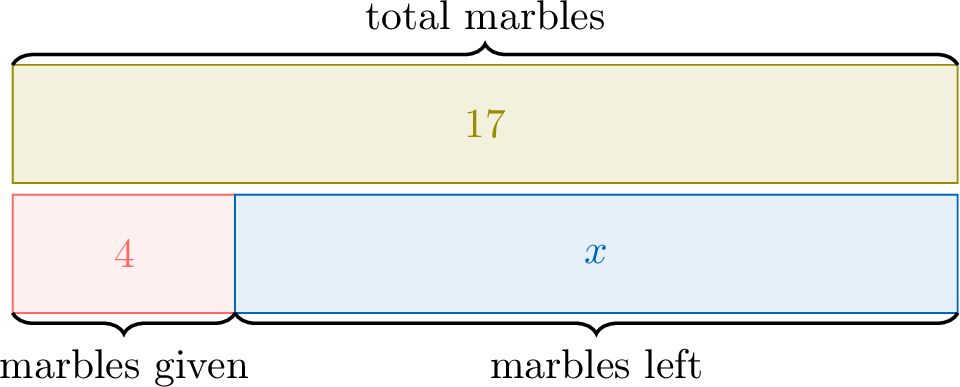
- The marbles left are \(\textcolor{olive}{17} - \textcolor{colordef}{4}=\textcolor{colorprop}{13}\)
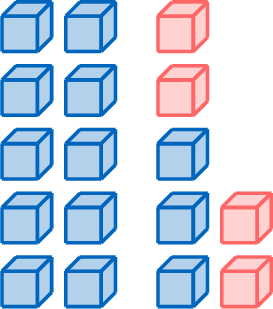 \(-\)
\(-\) \(=\)
\(=\)
Exercise
During the holiday, Anjelaï read 5 more books than the 7 books she had planned to read.
How many books did she read in total? books
How many books did she read in total?
- To find the total number of books Anjelaï read, start with the 7 books she planned to read and add the 5 extra books she read.
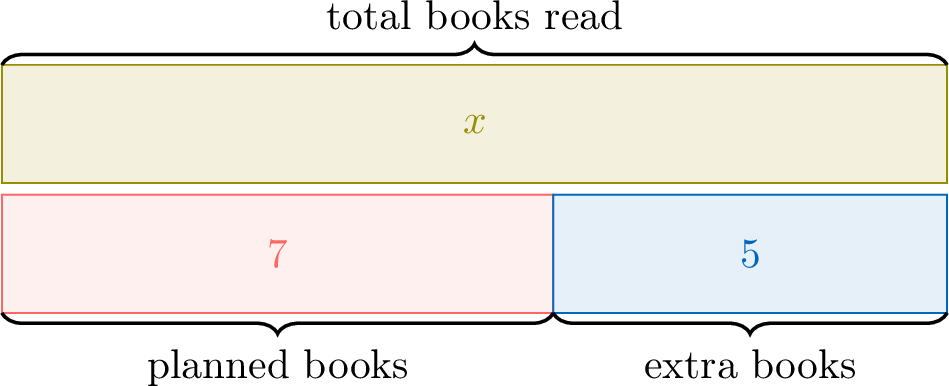
- So, the total number of books she read is \(\textcolor{colordef}{7} + \textcolor{colorprop}{5}=\textcolor{olive}{12}\) books.
 \(+\)
\(+\) \(=\)
\(=\)
Exercise
You buy something for 6 dollars. You give the seller a 10 dollar bill.
How much change will you get back? dollars
How much change will you get back?
- Start with the total amount given, which is 10 dollars, and subtract the cost of 6 dollars.
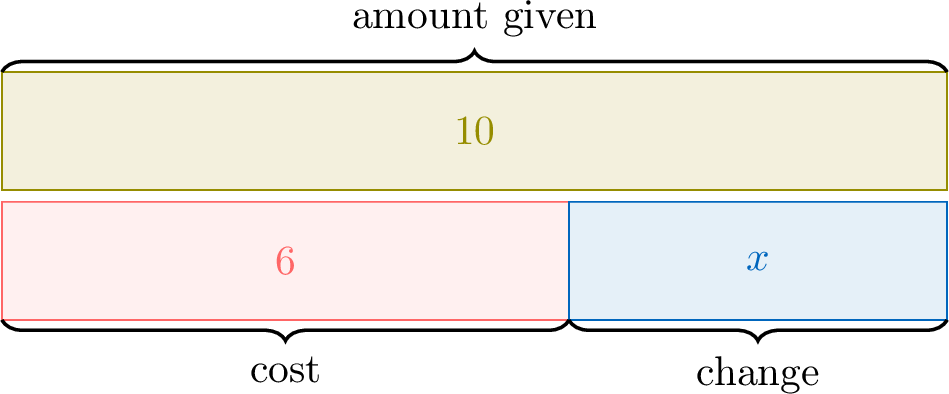
- The change you get back is \(\textcolor{olive}{10} - \textcolor{colordef}{6} = \textcolor{colorprop}{4}\) dollars.
 \(-\)
\(-\) \(=\)
\(=\)
Exercise
You start with 20 candies. You give 6 candies to a friend.
How many candies do you have left? candies
How many candies do you have left?
- Start with a total of 20 candies and subtract the 6 candies you gave away.
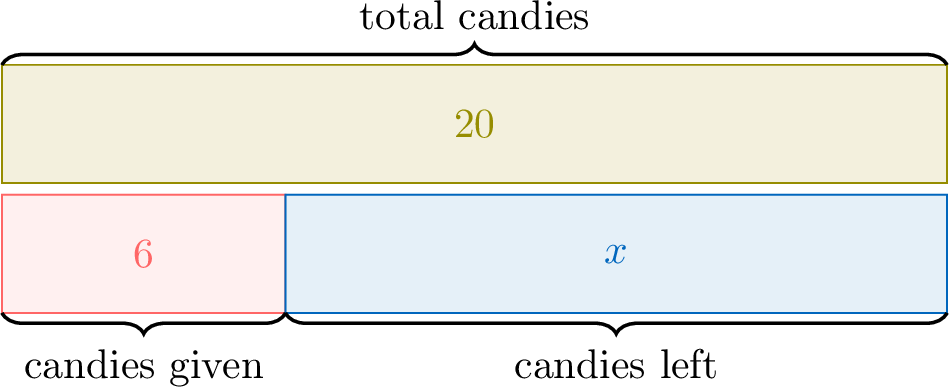
- The candies left are \(\textcolor{olive}{20} - \textcolor{colordef}{6}=\textcolor{colorprop}{14}\)
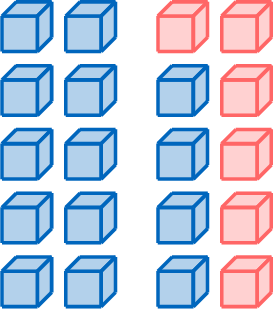 \(-\)
\(-\) \(=\)
\(=\)
Exercise
Li won 8 marbles during recess. Tonight, he has 15 marbles.
How many marbles did he have this morning? marbles
How many marbles did he have this morning?
- Start with the total number of marbles Li has now, which is 15 marbles, and subtract the 8 marbles he won.
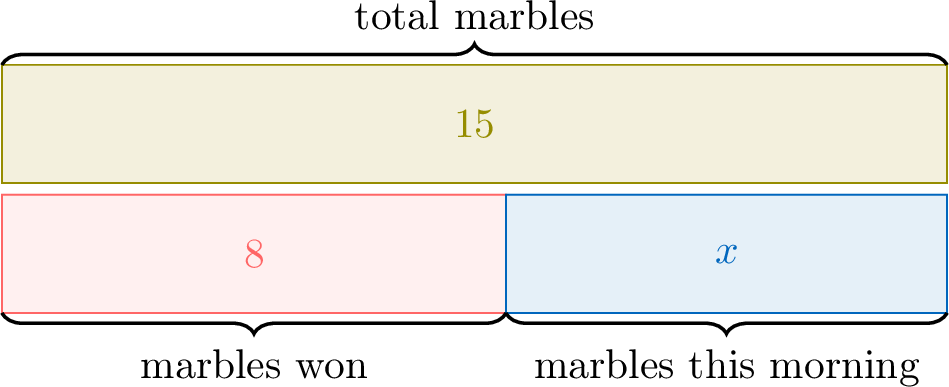
- The marbles he had this morning are \(\textcolor{olive}{15} - \textcolor{colordef}{8} = \textcolor{colorprop}{7}\).
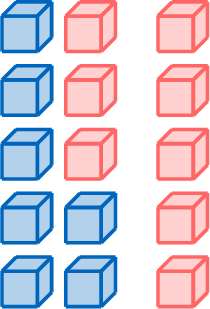 \(-\)
\(-\) \(=\)
\(=\)
Exercise
Emma found 5 seashells at the beach in the afternoon. Now she has 12 seashells.
How many seashells did she already have before going to the beach? seashells
How many seashells did she already have before going to the beach?
- Start with the total number of seashells Emma has now, which is 12, and subtract the 5 seashells she found.
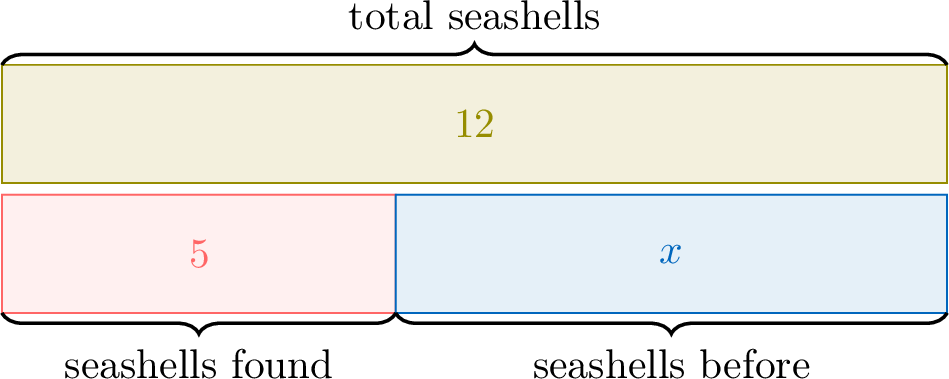
- The seashells she had before are \(\textcolor{olive}{12} - \textcolor{colordef}{5} = \textcolor{colorprop}{7}\).
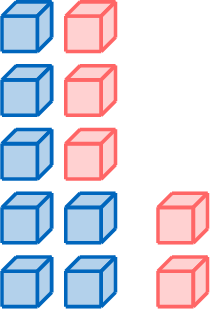 \(-\)
\(-\) \(=\)
\(=\)